Rose: Chapter 1
| Klicke hier für Deutsche Version | |
| Navigation: Main Page > Learn Othello > Book Rose | << previous chapter << - >> next chapter >> |
Chapter 1: Rules and notation
Diagram 1-1 shows the standard notation for Othello. The columns are labeled ‘a’ through ‘h’ from left to right, and the rows are labeled ‘1’ through ‘8’ from top to bottom. In this book, squares will be referenced using a small letter followed by a number, e.g., ‘a1’ for the upper-left corner and ‘h8’ for the lower-right corner. Certain squares are assigned special letters, which will be capitalized, as shown in Diagram 1-2. This notation was developed by Othello’s inventor, Goro Hasegawa, and remains in use today. The B-squares are in the center of the edge, the C-squares are on the edge next to the corner, and the A-squares lie between the B-squares and C-squares. The X-squares are diagonally adjacent to the corners, with the ‘X’ indicating danger.
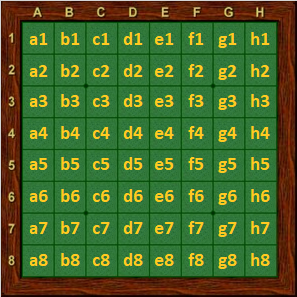 |
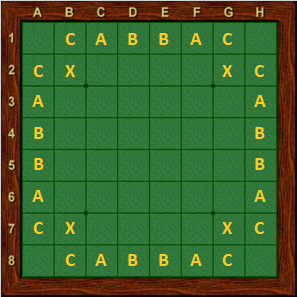 |
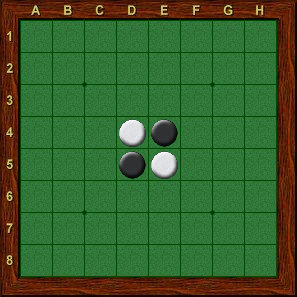
|
| Diagram 1-1 | Diagram 1-2 | Diagram 1-3 |
| Square names | Black to move |
Black and White, written with capital letters, will refer to the players, while lowercase letters (black and white) will refer to the color of the discs. For example: “at the end of the game there were more black discs than white discs, so Black won and White lost”. Black and White are referred to as “he”, although they could of course be “she”, as many women play Othello, including Carol Jacobs, who won the U.S. Othello Championship twice in a row.
Compass directions (north, south, east, west) are sometimes used to refer to areas of the board (top, bottom, right, and left, respectively).
Rules of the game
- The game begins with black discs on d5 and e4, and white discs on d4 and e5, as shown in Diagram 1-3.
- Players alternate taking turns, with Black moving first.
- A legal move consists of placing a new disc on an empty square, and flipping one or more of the opponent’s discs.
- Any of the opponent’s pieces which are ‘sandwiched’ between the disc just placed on the board and a disc of the same color already on the board should be flipped. Sandwiches can be formed vertically, horizontally, or diagonally. To form a sandwich, all of the squares between the new disc and the disc of the same color already on the board must be occupied by the opponent’s pieces, with no blank squares in between.
- Pieces may be flipped in several directions on the same move. Any pieces which are caught in a sandwich must be flipped; the player moving does not have the right to choose to not flip a disc.
- A new disc can not be played unless at least one of the opponent’s discs is flipped. If a player has no legal moves, that is, if no matter where the player places a new disc he could not flip at least one disc, that player passes his turn, and his opponent continues to make consecutive moves until a legal move becomes available to that player.
- If a player has at least one legal move available, he must make a move and may not pass his turn.
- The game continues until the board is completely filled or neither player has a legal move.
Scoring
Scoring is done at the end of game. The usual way to determine the score is to simply count the number of discs of each color, e.g., if there are 34 black discs and 30 white discs, then Black wins 34-30. If both players have the same number of discs, then the game is a draw.
In tournament play, if one player captures all of his opponents discs, the game is usually scored as a 64-0 victory for that player, regardless of the number of discs on the board. Further, in certain tournaments, such as the World Championship, empty squares are awarded to the winner. For example, if at the end of the game there are 32 black discs and 29 white discs, with 3 empty squares, the score is recorded as a 35-29 victory for Black.
Examples
Diagrams 1-4 through 1-9 show a sequence of moves at the start of the game to demonstrate the rules. In Diagram 1-4, Black makes the first move of the game to f5, sandwiching the white disc on e5 between this new disc and the black disc on d5. In the diagram, the numeral 1 on the disc on f5 indicates that this is where the first move is played. The diamond-shaped black disc on e5 indicates that this disc was white before the move, and was flipped as the result of Black’s move. Below the diagram, the phrase ‘White to move’ indicates that White will make the next move in the game. In Diagram 1-5, White plays to f6, sandwiching the disc on e5 diagonally using the existing white disc on d4. In Diagram 1-7, White plays to f4, flipping discs in two directions. The black disc on f5 is sandwiched between the new disc on f4 and the white disc on f6, while the black disc on e4 is sandwiched between f4 and d4. In Diagram 1-9, White plays to c5, sandwiching the black discs on d5 and e5 using the existing white disc on f5.
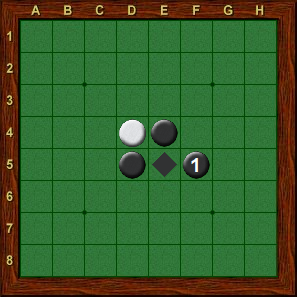 |
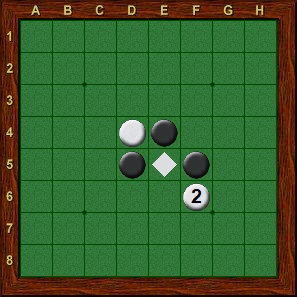 |
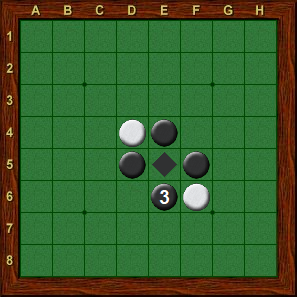
|
| Diagram 1-4 | Diagram 1-5 | Diagram 1-6 |
| White to move | Black to move | White to move |
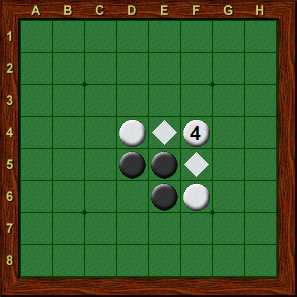 |
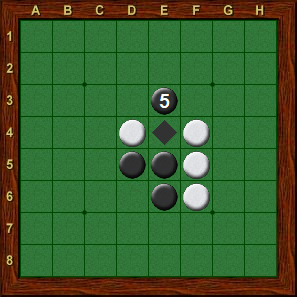 |
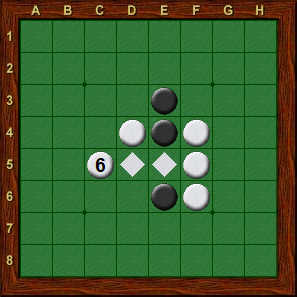
|
| Diagram 1-7 | Diagram 1-8 | Diagram 1-9 |
| Black to move | White to move | Black to move |
Suppose that in the position shown in Diagram 1-10, Black moves to f8. Diagram 1-11 shows the correct position after this move. The white disc on e6 is completely surrounded by black discs, but Black does not get to flip this disc, as it was not sandwiched by the move to f8. Diagram 1-12 shows a position in which White does not have a legal move. White passes, and Black moves again.
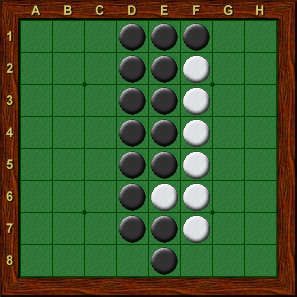 |
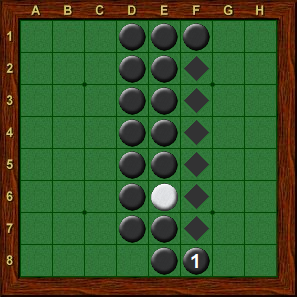 |
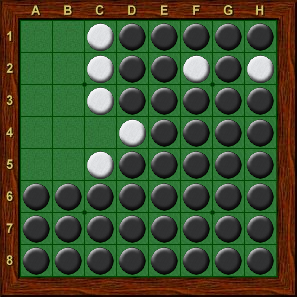
|
| Diagram 1-10 | Diagram 1-11 | Diagram 1-12 |
| Black to move | White to move | White passes |
Playing through a transcript.
Diagram 1-13 shows an example of a transcript of a complete game. The numbers indicate the order in which the moves were made, but not which pieces were flipped. To replay the game, place a black disc on the square marked 1 (f5 in this case), and flip pieces according to the normal rules of the game (e5 should be flipped to black in this case). Continue by playing a move for White on the square marked 2, a move for Black on the square marked 3, etc. Diagram 1-14 shows the position created after move 30, while Diagram 1-15 shows the final position. Partial transcripts are sometimes used to indicate a sequence of moves (see Diagram 2-9 for an example).
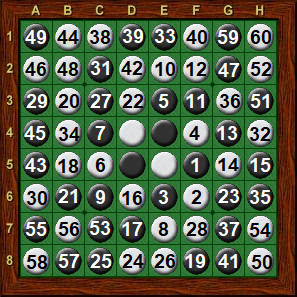 |
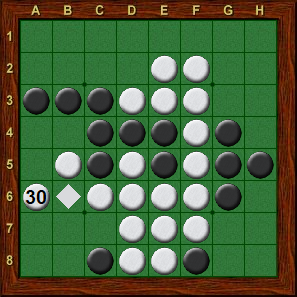 |
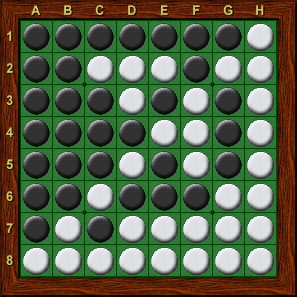
|
| Diagram 1-13 | Diagram 1-14 | Diagram 1-15 |
| Transcript | After move 30 | Final position |
| Navigation: Main Page > Learn Othello > Book Rose | << previous chapter << - >> next chapter >> |